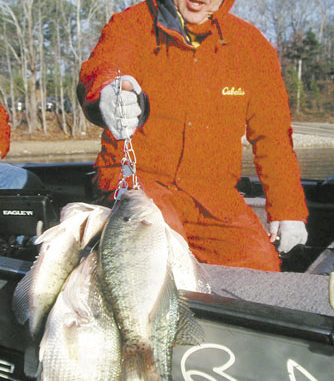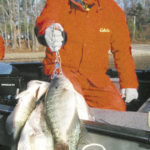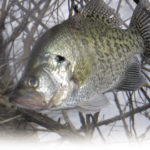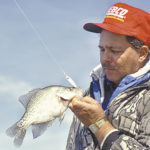
Late-winter crappie can be suckers for bigger baits when they’re fished in the right places.
Forget those jigs and minnows this month. You can catch crappie with the stuff in your bass tackle box in the last few weeks of winter almost as well as with traditional baits and lures. You may not catch 100 fish a day, but you’ll catch some slab-sized fish that will make your day on the water a success.
Charlie Ingram, a bass guide, discovered several years ago that before the weather warmed up in the spring, he was catching a lot of big crappie while bass fishing.
“I caught numbers of crappie on my jigging spoon where I found schools of crappie in standing timber,” said Ingram, who was catching slabs on a ¾-ounce Hopkins jigging spoon for several reasons.
“A spoon will drop straight down to the crappie and won’t be carried by the current, and gets down faster than either a minnow or a jig. And I can feel the spoon going down and my moving it up and down.”
One adjustment Ingram made was to dull the hook point on his spoons, since a big, sharp hook will cut a hole in the paper-like mouth of a crappie, and with any slack in the line at all, the hook will fall out of its mouth.
Besides his standard baitcasting outfit spooled with 14-pound Stren mono, Ingram relies on his depthfinder and trolling motor. The depthfinder enables him to see fish and/or the cover where the fish are concentrated. Usually, crappie will hold tight to the cover, and it you don’t put the spoon right on their noses, they probably won’t bite. Realize too, that crappie will move, and you must be able to follow them with your trolling motor.
Ingram learned that crappie hang out in the same kinds of places that bass do before both species make the move back in creeks as spring approaches — often suspended in cover along the edge of channels.
Just like bass, crappie move up and down vertical drops and hold on the breaks. Some of the most-productive places to find crappie include trees or brush tops that fishermen have sunk on the edges of river and creek channels.
“The jigging spoon, when fished through thick cover, is much like fishing a pig ’n jig through a (shallow) brush top when you’re bass fishing,” Ingram said. “The angler can fish every part of the cover: the outer edges, one side of the brush or right through the heart of the structure. If the cover’s thick, with only a few, small holes, a crappie fisherman can work that jigging spoon through those holes and take crappie — something he can’t do with a jig or a minnow.”
Ingram is a “target” fisherman who finds a spot on his depthfinder where he thinks crappie will hold, and then thoroughly works that structure until the crappie quit biting before he goes hunting another spot to fish.
“I don’t wait on (late winter) crappie to come to me; I go after them,” he said. “I take large numbers of crappie on cover although I never spot the fish on my depth finder.
“Usually, I’ll hit eight or 10 places in eight hours and will find crappie in 12 to 18 feet of water. No matter how bad the weather gets, I always can catch enough crappie using the jigging spoon to have a fish fry for two or three families besides my own.”
Most bass fishermen jig a spoon by lowering it to the bottom, ripping it up several feet and allowing it to fall back; bass will hit the spoon on the fall. For crappie, Ingram lets the spoon down until it touches structure and then slowly lifts and lowers his rod tip about four inches at a time.
“I tickle every limb in a brush top and work every part of the water, from the surface to the bottom and back up to the surface,” Ingram said. “I move my jigging spoon underwater the way I put a coffee spoon into a cup and take it out — slowly and gently.
“Remember, a crappie has a tender mouth. If you set the hook hard, you’ll rip its lips off. If you’ll just tighten the line up, you can land the crappie. Also, slow down your retrieve as the crappie gets near the surface. When the crappie comes to the top of the water, lift and swing it into the boat, rather than jerking the fish into the boat as you will a bass.”
Ingram carefully feels his jigging spoon from the time it enters the water until he brings it back into the boat. By not setting the hook when he feels a tap on the line, Ingram simply jiggles the spoon and shake it free, if the spoon bumps the cover. If that bump signifies a crappie, a hybrid or a catfish, Ingram usually has the fish hooked already.
“This style of crappie fishing pays big dividends,” Ingram says. “While I was crappie fishing with a jigging spoon, I even caught an 8½-pound largemouth.”
Ingram said fishermen “spooning up” crappie will usually run into “three or four bass in a day.
“Even if your buddies come by your boat, they’ll never know what you’re up to because you’re using a bass rod and reel, 14-pound line and a bass jigging spoon,” he said. “You can show off the bass you’ve caught, release them and go home with a a box full of crappie they haven’t seen.”
Most bass fishermen would never think of probing muddy water for bass before the temperature rises at least into the high 50s, but crappie fishermen aren’t hurt by high, colored water nearly as much — especially fast-moving water like that found in the upper reaches of reservoirs.
Veteran fisherman Danny Wiles showed off one day, catching big crappie in shallow, muddy water after a several days of heavy, late-winter rain.
“During flood-water conditions in the (late winter), crappie will move upstream to follow the baitfish that will feed there on the tremendous amounts of nutrients coming in with the water,” he said. “Since crappie don’t like swift water, they’ll concentrate and feed in eddy holes behind major current breaks where the baitfish are holding. You need fast water to find crappie stacked up.”
Wiles pointed to a boulder that interrupted the current. He cast a jig upstream of the rock and let the current wash it down, into the eddy pool. Each time, a crappie would respond by slamming the jig.
Current obstructions don’t need to be visible, either. Wiles moved to a different spot, and two big crappie hit on the first two casts.
“The crappie in the middle of the river are holding a huge, underwater boulder,” he said. “When that jig sweeps by the boulder into the eddy, the crappie holding there and feeding on the baitfish will spot it.”
In about four hours of fishing the swift water, we both had our limit of crappie, weighing from one to 2½ pounds each, in some very-cold weather.
Spinnerbaits will also knock late-winter crappie for a loop. Bass fisherman Phillip Criss showed up at his taxidermist’s shop one afternoon to mount a big bass, and in the bottom of his cooler he had four crappie that weighed better than two pounds apiece. Criss reported that he caught them around the same underwater logs and stumps where he’d taken the bass — with the same spinnerbait.
“I don’t want to catch any crappie that won’t hit spinnerbaits,” he said, “because I know if they do hit that lure, they’ll be slab-sized.
“When you go to an underwater apartment building made of stumps, logs and brush, if you fish really slowly, you don’t know which species will come out and take your spinnerbait — bass or crappie.”






Be the first to comment